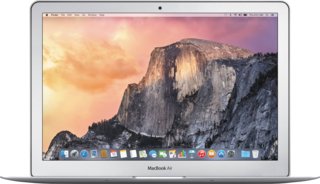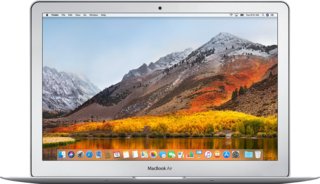Apple MacBook Air (2015) 13" vs Apple MacBook Air (2017) 13.3" Intel Core i5 128GB
Dive in with us as we compare the Apple MacBook Air 2015 and its newer counterpart, the MacBook Air 2017. We'll break down the specifics, turning technical details into easily digestible information. You'll get a clear view of what makes these two models different and similar. We focus on key features like processing power and storage capabilities, providing you with accurate insights into the evolution of this popular laptop series. We highlight each model's strengths and don't shy away from discussing their limitations. Whether you're a designer in need of a dependable tool or a student seeking the perfect mix of function and style, this comparison is tailored just for you. Let's dive deep into these two MacBook Airs!
System and application performance
Performance in popular 3D games
Viewing angle, color accuracy...
Ports, webcam and other interfaces
Potential battery life
Materials, durability and portability
Design Comparison
Size Comparison
Apple MacBook Air (2015) 13" vs. Apple MacBook Air (2017) 13.3": A Comparison of Designs
Ergonomics and Portability:
- Both models are lightweight, around 3 pounds each, making them easy to carry for users on the move. The thin 0.7-inch profile boosts portability while maintaining high performance.
Materials and Build Quality:
- Each laptop showcases a robust aluminum construction that offers a high-end appearance and durability for everyday use.
Keyboard and Connectivity:
- Both models feature a backlit keyboard for comfortable work in low-light conditions. The 2015 model includes USB 3.0 ports, while the 2017 model offers USB Type-C ports, catering to diverse connectivity requirements depending on peripheral compatibility.
User Experience Enhancements:
- Thunderbolt ports are included in both models to support high-speed data transfer and external display connectivity, boosting user productivity.
- Both laptops feature stereo speakers and a front camera, enhancing multimedia experiences for video calls or entertainment.
Aesthetic Appeal:
The modern aesthetic of both laptops, with sleek design and compact form factor, caters to professionals, students, and general users.
User Considerations:
For Students:
- 2015 Model: Suitable for students needing reliable performance with traditional USB connections for peripherals like external drives or printers.
- 2017 Model: Ideal for students looking for future-proofing with USB Type-C connectivity, enabling compatibility with newer devices and accessories.
For Professionals:
- 2015 Model: Offers a classic design with standard ports, suitable for professionals who rely on legacy peripherals or prefer proven technology.
- 2017 Model: Appeals to professionals seeking cutting-edge technology like Thunderbolt ports and USB Type-C support for advanced workflows and faster data transfers.
Conclusion:
Deciding between the Apple MacBook Air (2015) 13" and the Apple MacBook Air (2017) 13.3"? It's all about your personal needs! Both models boast a stylish design that enhances usability. However, they differ slightly in a few key areas:
- Port selection: Depending on your daily requirements, one may offer more of the ports you regularly use.
- Future-proofing: If staying ahead of the tech curve matters to you, consider which model is more up-to-date and likely to support future updates.
- Compatibility with existing peripherals: Have lots of gadgets and devices? Check which laptop will sync seamlessly with them.
Screen Comparison
| Apple MacBook Air (2015) 13" | Apple MacBook Air (2017) 13.3" Intel Core i5 128GB | |
|---|---|---|
| Refresh Rate | 60 hz | 60 hz |
| Resolution | HD | HD |
| Screen Size | 13.3" | 13.3" |
When comparing the screen specifications of the Apple MacBook Air (2015) 13" and the Apple MacBook Air (2017) 13.3", it's essential to consider various factors that can influence your viewing experience, particularly for activities such as gaming or professional graphic design.
Screen Size:
Both laptops have a 13.3-inch display, offering ample viewing space for different activities while remaining portable.
Resolution:
Both models provide a 1440 x 900 pixel resolution, ideal for daily tasks and general productivity. Yet, for graphic design or photo editing requiring greater visual clarity, opting for a higher resolution display to discern finer details may be more favorable.
Pixel Density:
The laptops have a pixel density of 127 pixels per inch (PPI), providing sharp and clear images and text on the screen. Higher pixel density can improve the visual experience, especially when dealing with intricate designs or detailed images.
Display Technology:
Both laptops come with an IPS LCD LED-backlit display that delivers vibrant colors and wide viewing angles, ensuring consistent color accuracy from various perspectives, ideal for collaborative tasks and content sharing.
Refresh Rate:
The standard refresh rate of 60Hz is suitable for daily computing tasks, but gamers may prefer a higher refresh rate for smoother gameplay and less motion blur.
Supported Displays:
Both laptops can connect up to three external displays, offering flexibility for multitasking or expanding your workspace. This capability is useful for professionals needing multiple screens to boost productivity.
Impact on Gaming:
The screen size and resolution of both laptops are suitable for casual gaming but may not deliver the sharpness and detail needed for high-end gaming experiences.
- Gamers may opt for a laptop with a higher resolution screen and potentially a faster refresh rate for improved graphics and minimized motion blur while gaming.
Impact on Professional Graphic Design:
Both laptops feature IPS LCD technology to ensure precise color reproduction, which is essential for graphic designers handling color-sensitive projects. For basic graphic design tasks, the resolution suffices; however, professionals working with detailed designs may benefit from a higher resolution display for better clarity on fine details.
Hardware Comparison
| Apple MacBook Air (2015) 13" | Apple MacBook Air (2017) 13.3" Intel Core i5 128GB | |
|---|---|---|
| RAM | 8GB | 8GB |
| Storage Size | 512GB | 128GB |
When assessing the hardware differences between the Apple MacBook Air (2015) 13" and the Apple MacBook Air (2017) 13.3" Intel Core i5 1.8GHz / 8GB / 128GB, various vital elements influence the laptops' performance and user experience.
CPU (Central Processing Unit):
- MacBook Air 2015: The 2015 model features a CPU speed of 2GHz, with a turbo clock speed that can reach up to 3.2GHz.
- MacBook Air 2017: In contrast, the 2017 model is equipped with an Intel Core i5 processor clocked at 1.8GHz, which can reach up to 2.9GHz with turbo boost.
Performance Comparison: The MacBook Air (2015) boasts faster CPU clock speeds, enhancing performance for demanding tasks like video editing and rendering. Conversely, the MacBook Air (2017) features a newer architecture that may deliver more efficient processing in specific scenarios, even with slightly lower clock speeds.
GPU (Graphics Processing Unit):
- Both models are integrated with Intel HD Graphics solutions suitable for everyday tasks and light gaming.
Performance Impact: For multimedia tasks like photo editing or watching high-definition videos, both laptops can handle them well due to their integrated GPUs. However, heavy software operations or demanding gaming may not be optimal on these machines due to limited GPU capabilities.
RAM (Random Access Memory):
- Both laptops include 8GB of RAM clocked at 1600MHz.
Performance Impact: The ample amount of RAM in both models ensures smooth multitasking capabilities and efficient handling of everyday applications. Users can comfortably run multiple programs simultaneously without experiencing significant slowdowns.
Storage:
- MacBook Air 2015: Offers internal storage capacity of 512GB using flash storage technology. MacBook Air 2017: Offers a storage capacity of 128GB with NVMe SSD technology.
Performance Comparison: The MacBook Air (2015) provides increased storage capacity, enabling users to store files and applications locally without depending on external drives. On the other hand, the MacBook Air (2017) features a smaller internal storage size, but its NVMe SSD may deliver faster read/write speeds for swift data access and quicker application loading times.
In conclusion, if you prioritize storage space over faster SSD performance, the MacBook Air (2015) might better meet your needs. Alternatively, if you value improved SSD speeds for quicker system responsiveness and boot times, then choosing the MacBook Air (2017) could be more advantageous.
Battery Comparison
| Apple MacBook Air (2015) 13" | Apple MacBook Air (2017) 13.3" Intel Core i5 128GB | |
|---|---|---|
| Battery Life | 14 hours | 12 hours |
Comparing the battery performance of the Apple MacBook Air (2015) 13" and the Apple MacBook Air (2017) 13.3" Intel Core i5 1.8GHz / 8GB / 128GB reveals significant differences worth noting:
Apple MacBook Air (2015) 13":
Battery Life: Enjoy up to 14 hours of usage time on a single charge with the MacBook Air (2015). Sleep And Charge USB Ports: This feature enables you to charge external devices while your laptop is in sleep mode, providing added convenience and flexibility to your workflow. Magsafe Power Adapter: The MagSafe power adapter enhances safety by swiftly disconnecting from the laptop when the cord is pulled, minimizing the chance of accidental damage.
Apple MacBook Air (2017) 13.3" with Intel Core i5 processor, 8GB RAM, and 128GB storage:
Battery Life: The MacBook Air (2017) features a slightly shorter battery life of up to 12 hours in comparison to its previous model. Magsafe Power Adapter: This version includes a MagSafe power adapter for convenient connection and disconnection.
In summary, the Apple MacBook Air (2015) boasts a longer battery life of up to 14 hours and comes with added features such as Sleep And Charge USB Ports. On the other hand, the Apple MacBook Air (2017) offers a 12-hour battery life, delivering reliable performance along with the convenience of a Magsafe Power Adapter for secure charging.
Verdict
Why Apple MacBook Air (2015) 13"?
- Larger internal storage capacity of 512GB for storing files and applications locally.
- Longer battery life of up to 14 hours for extended usage without frequent recharges.
- Faster CPU clock speeds, ideal for demanding tasks like video editing and rendering.
Why ?
- The Apple MacBook Air (2017) offers USB Type-C ports for future-proof connectivity.
- The MacBook Air (2017) features NVMe SSD technology for faster data access and application loading times.
- The 2017 model includes a newer Intel Core i5 processor architecture for potentially more efficient processing.
- The Apple MacBook Air (2017) provides a sleek design with updated Thunderbolt ports for enhanced productivity.
Similar comparisons
- Apple MacBook (2016) vs Apple MacBook Air (2015) 13"
- Apple MacBook Air (2015) 11" vs Apple MacBook Pro (2015) 13"
- Apple MacBook (2016) vs Samsung Chromebook 4 Plus 15.6" Intel Celeron N4000
- Apple MacBook (2016) vs Apple MacBook Air (2020) 13.3" Apple M1
- Apple MacBook (2016) vs Lenovo Yoga 900 Business Edition 13.3" Intel Core i7-6560U

